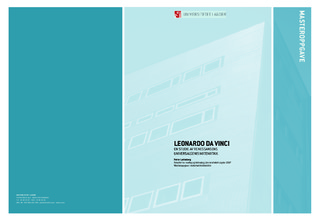Leonardo da Vinci : en studie av renessansens universalgenis matematikk
Abstract
I første del av oppgaven skisserer jeg hvilken plass matematikkens historie har hatt og har i
skolehverdagen. At den i dag har en mer sentral plass enn tidligere virker klart, og jeg
redegjør for hvilke tanker som ligger bak denne implementeringen.
Videre gjengir jeg i korte trekk Leonardo da Vincis liv og samtid, der jeg prøver å skape en
forståelse for hvilken livssituasjon og sosial kontekst som kan ha preget hans interesser og
arbeid. Deretter vektlegges hans matematiske virke, der jeg kort gjør rede for hvilke områder
han arbeidet med innen matematikk. Jeg har valgt å avgrense denne oppgaven til kun å
omhandle da Vincis ”rene” matematikk. Hans mekanikk, ingeniørkunst og kunstneriske virke
er i stor grad utelatt fra denne oppgaven, da dette ville gjort oppgaven for omfattende.
Allikevel vil man underveis også finne referanser til hans arbeid her, men det er da tatt med
for å sette ting i en sammenheng.
Tre hovedområder innen hans matematikk behandles mer utfyllende; sirkelens kvadratur,
kubens fordobling og perspektivtegning. Innenfor disse områdene har jeg sett på hva som
allerede var kjent før Leonardos tid, hva Leonardo eventuelt bidro med, samt kort om hva som
fulgte etter Leonardo. Og i så fall om dette kunne skyldes påvirkning fra Leonardo da Vincis
arbeid. Et lite kapittel omhandler hva som finnes igjen av Leonardos matematikk idag.
Tilslutt i oppgaven gjennomfører jeg en klasseromsundersøkelse der jeg lar to ulike
elevgrupperinger prøve seg på geometrioppgaver basert på Leonardos arbeid. Disse
analyseres, og jeg finner at det blant disse elevene finnes flere spennende tilnærminger til
hvordan disse oppgavene kan løses. In the first part of my thesis I outline the role the history of mathematics has played in
everyday life at school, and the role it has today. It seems evident that the history of
mathematics is a larger part of today’s curriculum, and I show the views behind this
development.
I move on to a brief description of Leonardo da Vinci’s life and the period he lived in, where I
try to show and explain which areas of life and which social contexts might have influenced
his life and work. Afterwards I focus on his mathematical work, giving an account of which
areas he worked on within mathematics. I have chosen to limit this thesis to da Vinci’s “pure”
mathematics. His mechanics, engineering and artistic efforts are mostly left out of this thesis,
as they would make the thesis too extensive. In spite of this, some reference to these areas of
his work will be made, but only to put things into context.
Three main areas of his mathematics will be treated more extensively than others; The
squaring of the circle, the doubling of the cube, and perspective. Within these areas I have
looked at what was known before da Vinci, what da Vinci might have contributed and briefly
what followed da Vinci, considering whether this could be shaped by influence from da
Vinci’s work. A small chapter regards what is left of da Vinci’s mathematics today.
Finally I describe a survey I conducted in the classroom, where I let two different groups of
students try their hand at geometry tasks based on da Vinci’s work. The result of this survey is
analysed, and I find that amongst these students there are several fascinating approaches to
solving these problems.
Description
Masteroppgave i matematikkdidaktikk - Universitetet i Agder 2007
